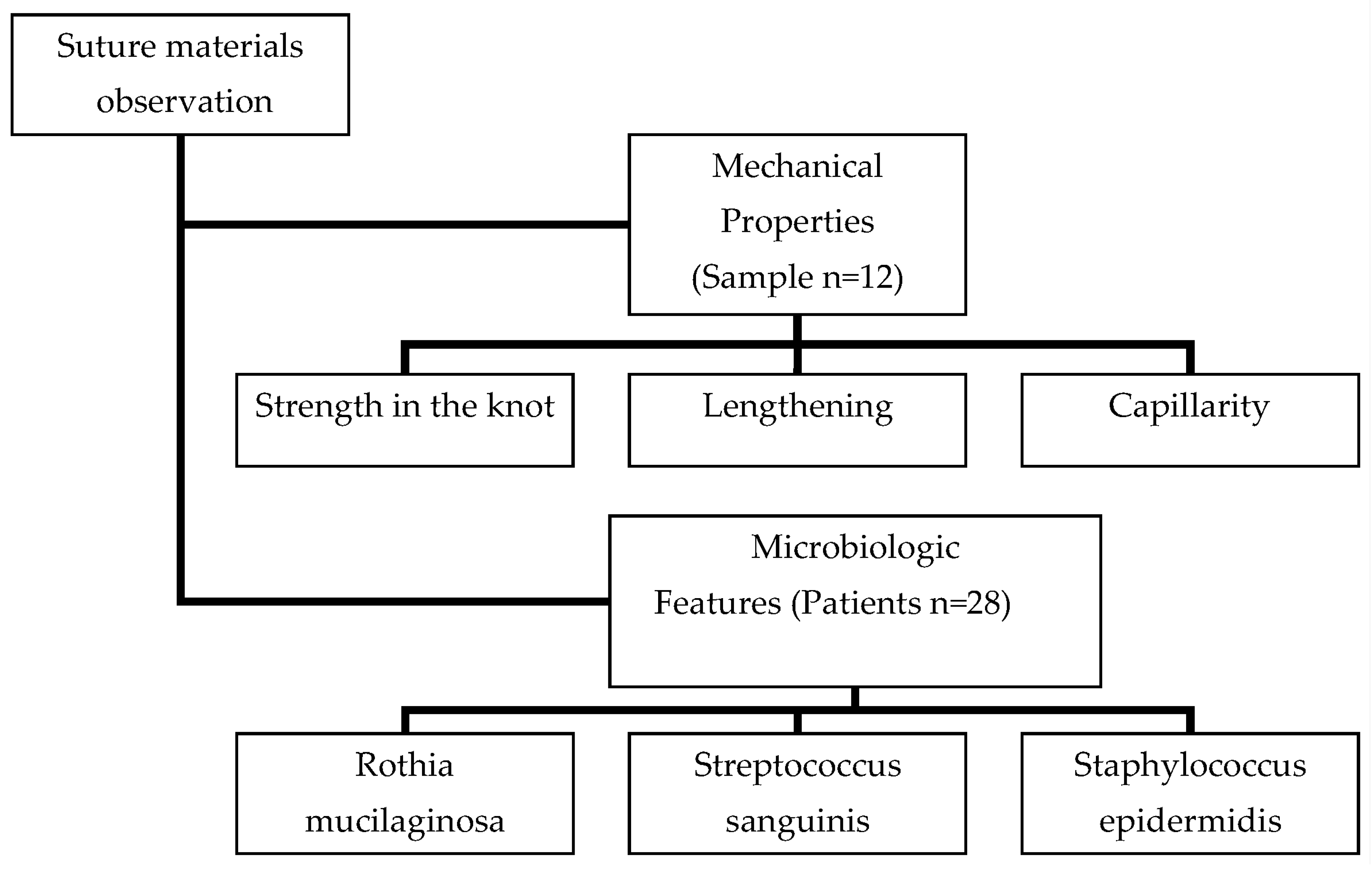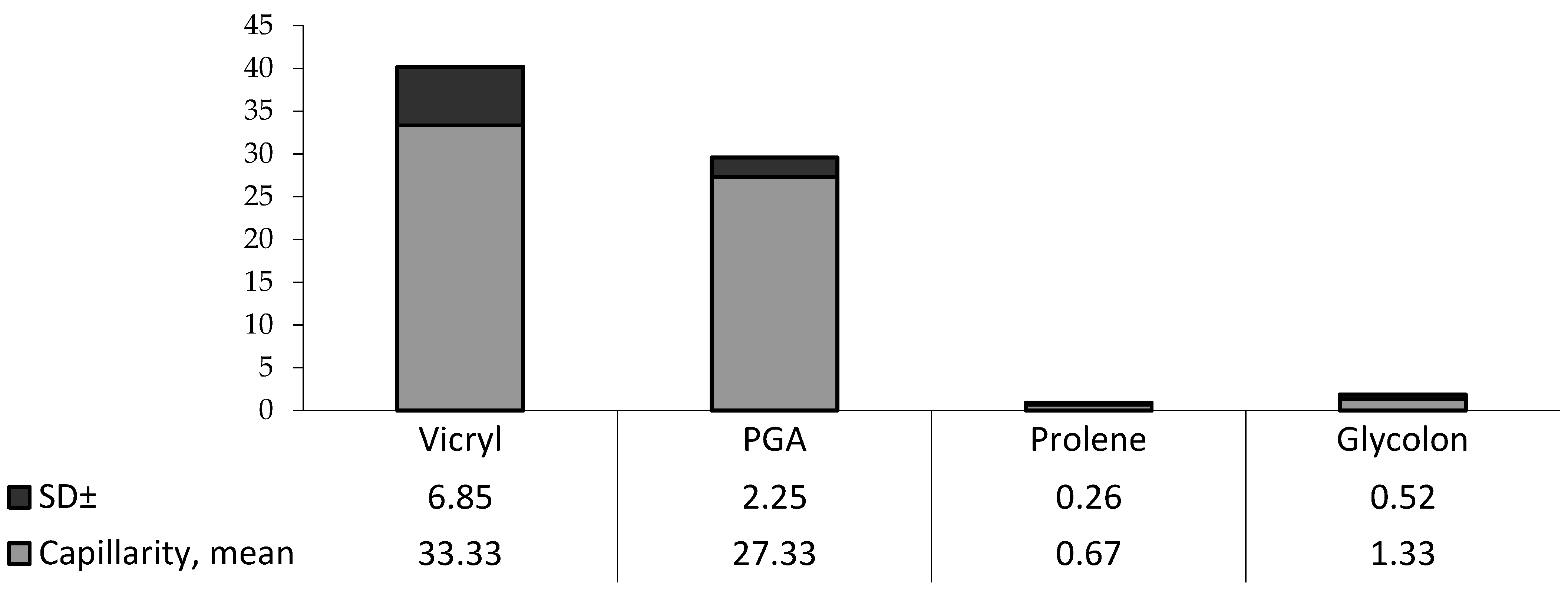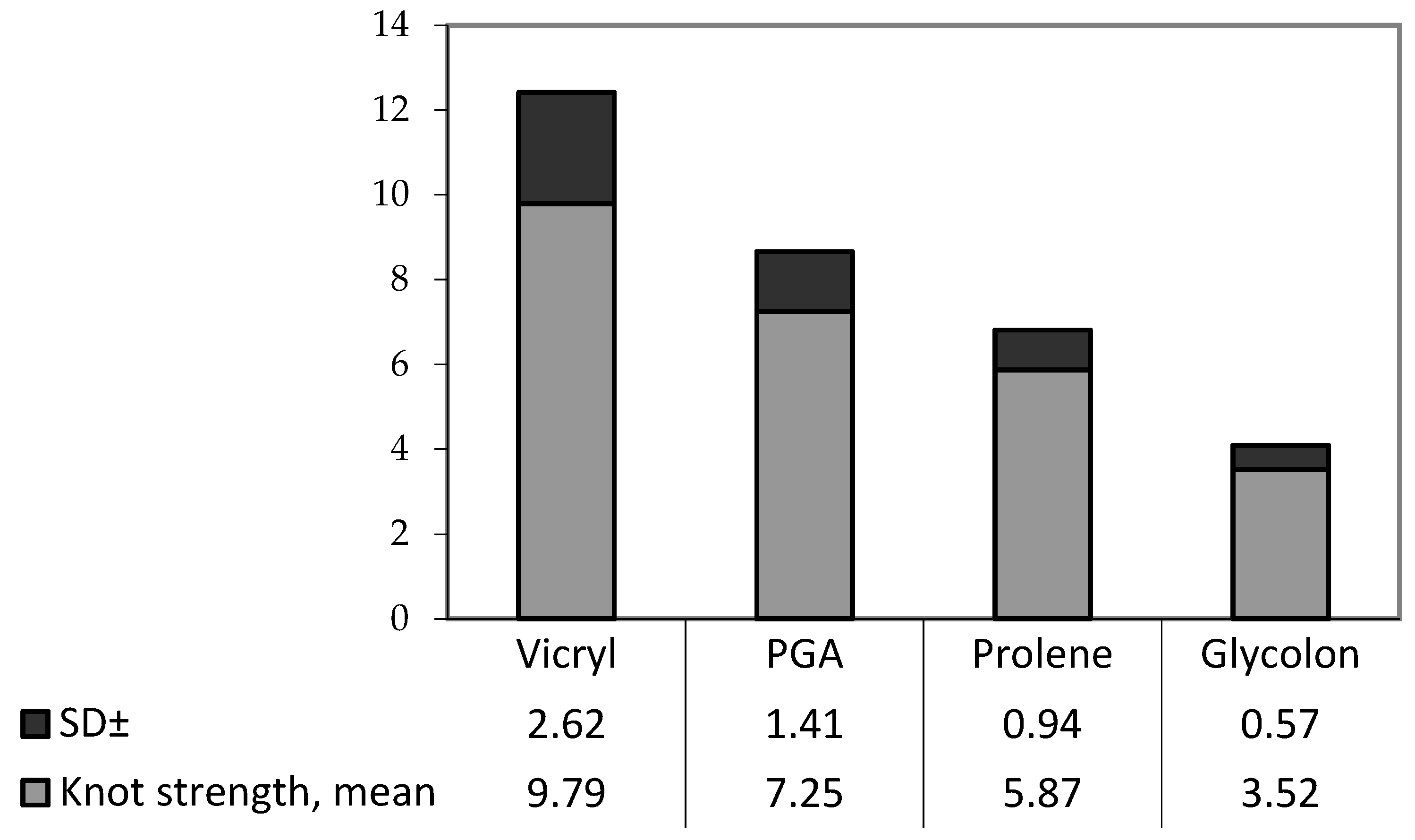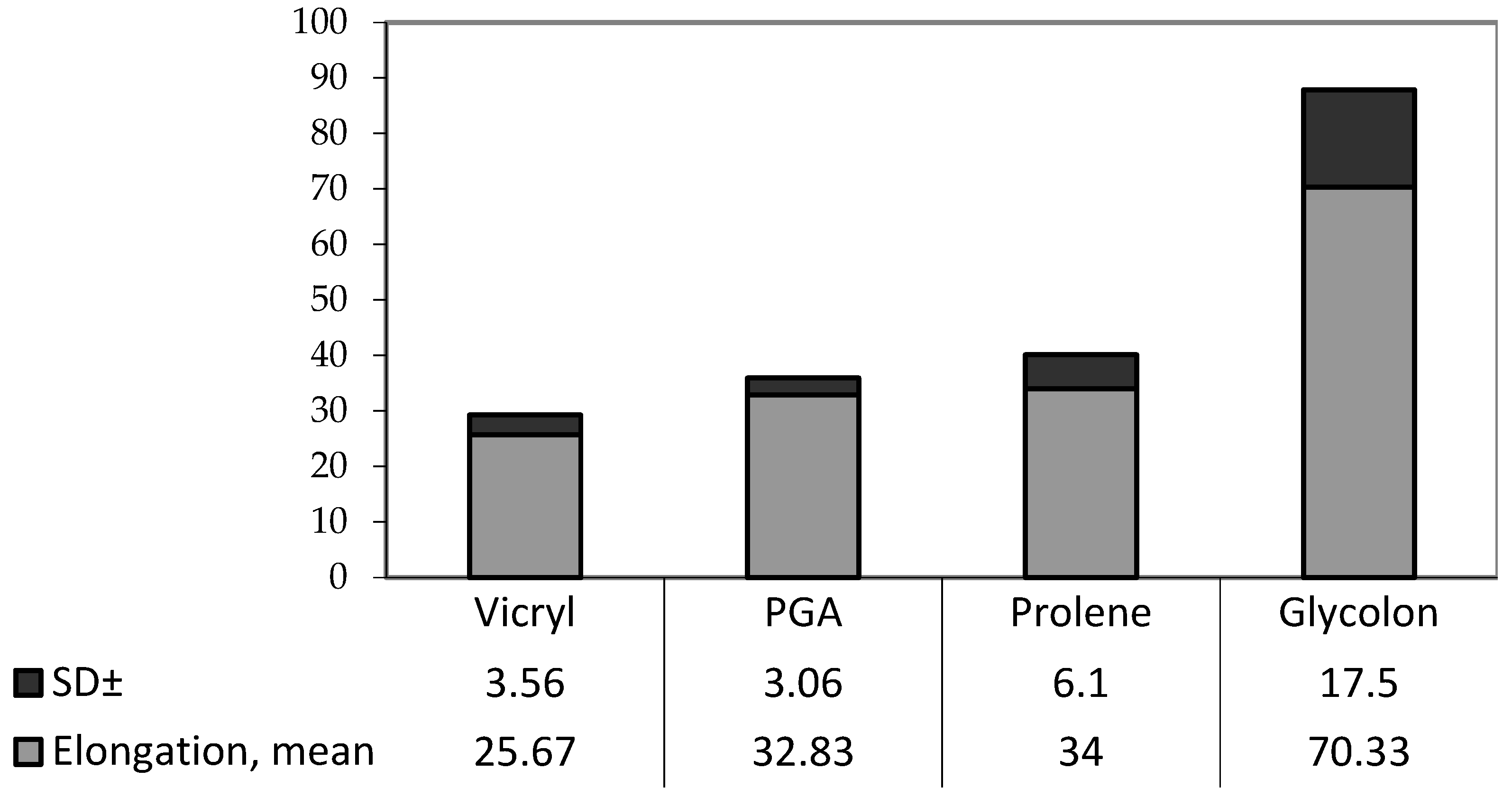Comparative Analysis of Mechanical Properties and Microbiological Resistance of Polyfilament and Monofilament Suture Materials Used in the Operation “Tooth Extraction”
Abstract
:1. Introduction
2. Materials and Methods
2.1. Study of Mechanical Properties
2.1.1. Absorption Properties
2.1.2. Tensile Strength at the Knot and Elasticity of the Material
2.2. Microbiological Examination
- Availability of informed written consent of the patient to participate in the study
- The age of the patient is from 18 to 70 years
- Male and female patients
- Indication for extraction of the teeth of the upper and lower jaws
- Absence of severe somatic diseases
- Age less than 18 years
- Pregnancy, breastfeeding
- The presence of concomitant diseases in the stage of exacerbation and decompensation
- Lack of indications for tooth extraction
- Refusal of the patient of further participation in the study
- Exacerbation of concomitant pathologies
- Failure to comply with medical recommendations
- Seeding of the test material in nutrient media
- 2.
- Isolation of a pure culture
- 3.
- Identification of microorganisms (determination of belonging to a species).
2.3. Statistical Processing of the Received Data
3. Results
3.1. Results of the Study of Mechanical Properties
3.1.1. Absorption Properties
3.1.2. Tensile Strength at the Knot and Elasticity of the Material
- −
- Vicryl had the highest knot force compared to PGA and Glycolon.
- −
- Glycolon had the lowest knot force.
- −
- Monofilament sutures of Prolene and Glycolon have lower knot strength compared to polyfilament sutures of Vicryl and PGA Resorba (p < 0.05).
- −
- Vicryl had the lowest extensibility compared to PGA, Prolene and Glycolon.
- −
- Glycolon had the highest extensibility.
3.2. Microbiological Investigation
- −
- Most of the Rothia bacteria mucilaginosa was found on Vicryl samples (p < 0.05) compared to PGA, Prolene and Glycolon.
- −
- Glycolon and Prolene showed lower bacterial contamination than Vicryl and PGA (monofilament sutures predominate over polyfilament sutures) (p < 0.05).
- −
- Vicryl was the most inoculating material in comparison with PGA, Prolene and Glycolon.
- −
- Within the group of monofilament materials, no difference was found
- −
- PGA had more bacteria on its surface than Prolene and Glycolon.
- −
- No differences were found between Vicryl and PGA (p > 0.05).
- −
- The best in terms of Staphylococcus epidermidis turned out to be Prolene (p < 0.05).
4. Discussion
- −
- PGA was average in all three experiments.
- −
- Glycolon and Prolene, as representatives of monofilament threads, had the lowest capillarity, which means the lowest probability of infection of surrounding tissues. With a high extensibility, followed by a weakening of the tension of the wound edges, these materials continue to have a high susceptibility to the formation of bacterial plaque.
- −
- The physical properties of Glycolon are slightly worse than Prolene.
- −
- Rothia mucilaginosa is a Gram-positive, coagulase-negative, encapsulated, non-spore-forming and non-motile coccus that is part of the normal flora of the oropharynx [12]. This bacterium forms biofilms such as Pseudomonas aeruginosa and R. mucilaginosa, a cohabitant in the lower respiratory tract of a patient with bronchiectasis, and is associated with the occurrence of severe bacteremia in immunocompromised patients [13].
- −
- Streptococcus sanguinis, formerly known as Streptococcus sanguis, is a facultative Gram-positive anaerobic bacterium that is part of dental plaque. Streptococcus sanguinis can enter the bloodstream after surgery and colonize the heart valves, especially the mitral and aortic valves, where it is the most common cause of subacute bacterial endocarditis. For this reason, surgeons often prescribe a short course of antibiotics to be taken a few days before and a few days after oral surgery [14].
- −
- Staphylococcus epidermidis is a Gram-positive bacterium that causes biofilm growth and allows other bacteria to bind to an existing one, creating a multi-layered biofilm. Patients with weakened immune systems are at risk of developing infection [15].
- −
- Monofilament materials are more preferable than polyfilament ones.
- −
- Vicryl most often had the largest number of bacteria on its surface.
- −
- No differences were found between Prolene and Glycolon in intraoperative fences.
- −
- The number of microorganisms on Prolen and Glycolon on day 7 was less than on PGA and Vicryl, while in the last experiment for the detection of Staphylococcus epidermidis, Prolene was better.
5. Conclusions
Author Contributions
Funding
Institutional Review Board Statement
Data Availability Statement
Acknowledgments
Conflicts of Interest
References
- Pershukov, A.V. Suture material in dentistry. Scientist 2021, 2, 12. [Google Scholar]
- Pettinari, M.J.; Nikel, P.I.; Ruiz, J.A.; Méndez, B.S. ArcA redox mutants as a source of reduced bioproducts. J. Mol. Microbiol. Biotechnol. 2008, 15, 41–47. [Google Scholar] [CrossRef] [PubMed]
- Stepanov, E.A.; Mitrofanova, N.N.; Stepanov, D.A.; Melnikova, V.V. Features of purulent-septic infection in patients with pathologies of the maxillofacial region. Izvestiya vysshih uchebnyh zavedenij. Povolzhsky region. Med. Sci. 2019, 2, 50–61. [Google Scholar] [CrossRef]
- Tarasenko, S.V.; Katola, V.M.; Komogortseva, V.E. Effect of oral microbiota on the development of inflammation and somatic diseases. Ross. Stomatol. Mag. 2018, 3, 162–165. [Google Scholar] [CrossRef]
- Sharkov, S.M.; Ikhsanova, S.R. Use of triclosan-coated suture material as prevention of surgical site infections. Wounds and wound infections. Prof. BM Kostyuchenok J. 2021, 2, 28–32. [Google Scholar] [CrossRef]
- Denisov, A.A.; Gurtovoy, D.E. Overview of Modern Methods of Production of Impregnated Suture Materials. Innova 2020, 4, 8–11. [Google Scholar] [CrossRef]
- Morozov, A.M. Possibilities of developing a new biologically active suture material in surgery. Vestn. Exp. I Clin. Khirurgii 2019, 3, 193–198. [Google Scholar] [CrossRef]
- Bontsevich, D.N. Capillarity and wickedness of modified and traditional suture material. Probl. Healthy I Ecol. 2007, 135–140. [Google Scholar]
- Lipatov, V.A.; Severinov, D.A.; Denisov, A.A.; Lazarenko, S.V.; Grigoriev, N.N. Study of the physical and mechanical characteristics of the suture material in the experiment during operations on the liver. Ross. Med. -Biol. Vestn. Nameni Acad. IP Pavlov. 2020, 2, 193–199. [Google Scholar] [CrossRef]
- Osypchuk, N.O.; Nastenko, V.B.; Shirobokov, V.P.; Korotkyi, Y.V. Sensitivity of antifungal preparations of Candida isolates from sub-biotopes of the human oral cavity. Regul. Mech. Biosyst. 2020, 1, 82–87. [Google Scholar] [CrossRef]
- Mosolova, A.V.; Klimova, L.G.; Sukovatykh, B.S.; Zatolokina, M.A.; Semykin, D.A.; Zatolokina, E.S. Evaluation of the Biocidal Activity of A new Suture Material Impregnated with Miramistin. Vestn. Volgogr. State Med. Univ. 2021, 1, 31–35. [Google Scholar] [CrossRef]
- Chervinets, V.M.; Chervinets, Y.V.; Leontieva, A.V.; Kozlova, E.A.; Stulov, N.M.; Belyaev, V.S.; Grigoryants, E.O.; Mironov, A.Y. Microbiome of the Oral Cavity in Patients with Periodontitis, Adhesive and Bio-Film-Forming Properties. Clin. Lab. Diagn. 2021, 1, 45–51. [Google Scholar] [CrossRef] [PubMed]
- Tlustenko, V.P.; Bayrikov, I.M.; Trunin, D.A.; Komlev, S.S.; Zhestkov, A.V.; Lyamin, A.V. The influence of various types of removable structures and dental implants on the microbiocenosis of the oral cavity in orthopedic treatmen. Vestn. Russ. State Med. Univ. 2019, 58–63. [Google Scholar] [CrossRef]
- Ryabinin, I.A.; Remneva, N.P.; Filonova, T.V.; Kovyrshin, S.V.; Kashuba, V.M.; Tsvetkova, G.V.; Vasilyeva, N.V. Taxonomic Structure of Streptococcus Spp Clinical Isolates. Based On Mass Spectrometric Differentiation. Probl. Med. Mikol. 2021, 2, 40–45. [Google Scholar] [CrossRef]
- Karpunina, T.I.; Yakusheva, D.E.; Kiselkov, D.M.; Borisova, I.A.; Yakushev, R.M. Decreased colonization of polydimethylsiloxane by Staphylococcus epidermidis. Vestn. Permsk. Univ. Seriya Biol. 2016, 160–165. [Google Scholar]
- Pleshkov, V.V. Investigation of mechanical properties of absorbable and non-absorbable suture materials. Smolensk. Med. Al’manah 2021, 80–84. [Google Scholar]
- Knyazyuk, A.S. Prevention of infections of the surgical intervention area by using antibacterial suture material. Probl. Healthy I Ecol. 2017, 1, 13–19. [Google Scholar]







| Suture Material | Vicryl | Prolene | Glycolon | PGA Resorba |
|---|---|---|---|---|
| Production material | Synthetic | Synthetic | Synthetic | Synthetic |
| Biodegradation | Absorbable | Non-absorbable | Absorbable | Absorbable |
| Structure | Polyfilament | Monofilament | Monofilament | Polyfilament |
| Manufacturer | Ethicon | Ethicon | Resorba | Resorba |
| Country | USA | USA | Germany | Germany |
| Mechanical Characteristics | Vicryl Mean + SD Median Min–Max | PGA Mean + SD Median Min–Max | Prolene Mean + SD Median Min–Max | Glycolon Mean + SD Media Min–Max | p |
|---|---|---|---|---|---|
| Knot strength (in Newtons) | 9.79 ± 2.62 9.28 7.2–13.4 | 7.25 ± 1.41 6.9 5.8–9.1 | 5.87 ± 0.94 5.75 4.7–7.4 | 3.52 ± 0.57 3.45 2.9–4.5 | p = 0.0048 |
| Elongation (in mm) | 25.67 ± 3. 56 25.5 21.0–3.0 | 32.83 ± 3. 06 32.5 29. 0–38.0 | 34.0 ± 6.1 34.0 26.0–44.0 | 70.33 ± 17.5 72.5 47.0–95.0 | p = 0.00049 |
| Capillarity (in mm) | 33.33 ± 6.85 30.5 27.5–42.0 | 27.33 ± 2.25 27.00 25.0–30.0 | 0.67 ± 0.26 0.5 0.5–1.0 | 1.33 ± 0.5 2 1.0 1.0–2.0 | p = 0.00018 |
| Bacteria | Vicryl Mean + SD Median Min–Max | PGA Mean + SD Median Min–Max | Prolene Mean + SD Median Min–Max | Glycolon Mean + SD Median Min–Max | p |
|---|---|---|---|---|---|
| Rothia mucilaginosa (cfu/smear) | 140 ± 124 140 20–400 | 133 ± 77 140 20–240 | 95 ± 40 100 30–140 | 68 ± 32 65 20–120 | p = 0.10664 |
| Streptococcus sanguinis (cfu/smear) | 300 ± 102 300 200–500 | 193 ± 79 200 100–300 | 79 ± 41 100 25–120 | 93 ± 53 100 20–150 | p = 0.00077 |
| Staphylococcus epidermidis (cfu/smear) | 134 ± 116 120 20–360 | 123 ± 96 100 20–300 | 134 ± 115 100 20–340 | 184 ± 162 120 40–500 | p = 0.88753 |
| Bacteria | Vicryl Mean + SD Median Min–Max | PGA Mean + SD Median Min–Max | Prolene Mean + SD Median Min–Max | Glycolon Mean + SD Median Min–Max | Kruskal–Wallis (p) |
|---|---|---|---|---|---|
| Rothia mucilaginosa (cfu/smear) | 594 ± 130 630 400–730 | 394 ± 40 395 330–350 | 283 ± 77 305 120–360 | 210 ± 96 200 100–380 | p = 0.0002 |
| Streptococcus sanguinis (cfu/smear) | 301 ± 59 300 220–380 | 269 ± 34 270 220–320 | 183 ± 39 200 120–220 | 206 ± 49 220 100–240 | p = 0.00044 |
| Staphylococcus epidermidis (cfu/smear) | 413 ± 101 370 330–600 | 493 ± 169 500 300–800 | 214 ± 51 200 160–310 | 286 ± 66 300 200–360 | p = 0.00051 |
Disclaimer/Publisher’s Note: The statements, opinions and data contained in all publications are solely those of the individual author(s) and contributor(s) and not of MDPI and/or the editor(s). MDPI and/or the editor(s) disclaim responsibility for any injury to people or property resulting from any ideas, methods, instructions or products referred to in the content. |
© 2023 by the authors. Licensee MDPI, Basel, Switzerland. This article is an open access article distributed under the terms and conditions of the Creative Commons Attribution (CC BY) license (https://creativecommons.org/licenses/by/4.0/).
Share and Cite
Pcheliakov, A.A.; Diachkova, E.Y.; Vasil’ev, Y.L.; Svitich, O.A.; Poddubikov, A.V.; Evlashin, S.A.; Volel, B.A.; Bakhmet, A.A.; Klochkova, S.V.; Velichko, E.V.; et al. Comparative Analysis of Mechanical Properties and Microbiological Resistance of Polyfilament and Monofilament Suture Materials Used in the Operation “Tooth Extraction”. Biomimetics 2023, 8, 129. https://doi.org/10.3390/biomimetics8010129
Pcheliakov AA, Diachkova EY, Vasil’ev YL, Svitich OA, Poddubikov AV, Evlashin SA, Volel BA, Bakhmet AA, Klochkova SV, Velichko EV, et al. Comparative Analysis of Mechanical Properties and Microbiological Resistance of Polyfilament and Monofilament Suture Materials Used in the Operation “Tooth Extraction”. Biomimetics. 2023; 8(1):129. https://doi.org/10.3390/biomimetics8010129
Chicago/Turabian StylePcheliakov, Alexey A., Ekaterina Yu. Diachkova, Yuriy L. Vasil’ev, Oxana A. Svitich, Alexander V. Poddubikov, Stanislav A. Evlashin, Beatrice A. Volel, Anastasia A. Bakhmet, Svetlana V. Klochkova, Ellina V. Velichko, and et al. 2023. "Comparative Analysis of Mechanical Properties and Microbiological Resistance of Polyfilament and Monofilament Suture Materials Used in the Operation “Tooth Extraction”" Biomimetics 8, no. 1: 129. https://doi.org/10.3390/biomimetics8010129
APA StylePcheliakov, A. A., Diachkova, E. Y., Vasil’ev, Y. L., Svitich, O. A., Poddubikov, A. V., Evlashin, S. A., Volel, B. A., Bakhmet, A. A., Klochkova, S. V., Velichko, E. V., Tiunova, N., & Tarasenko, S. V. (2023). Comparative Analysis of Mechanical Properties and Microbiological Resistance of Polyfilament and Monofilament Suture Materials Used in the Operation “Tooth Extraction”. Biomimetics, 8(1), 129. https://doi.org/10.3390/biomimetics8010129








